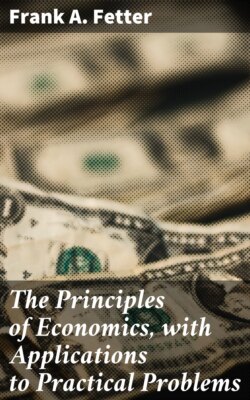Читать книгу The Principles of Economics, with Applications to Practical Problems - Frank A. Fetter - Страница 53
На сайте Литреса книга снята с продажи.
§ I. DIFFERENTIAL ADVANTAGES IN CONSUMPTION GOODS
ОглавлениеConnection between gratification, rents, and value of wealth
1. Both rent and the value of durable wealth are based on the value of the fruits or products yielded by the wealth. Gratification, afforded directly or indirectly, is the basis of all values. The relation of most kinds of wealth to wants is indirect; but gratification thus afforded indirectly is none the less the basis on which the usufruct of wealth is estimated. Men find the logical or causal connection between direct goods, or final product, and indirect goods, or agents.
To explain the value of the durable wealth, or rent-bearer, a still farther step in thought must be taken. The value of the rent-bearer is based on the series of rents which it affords. To explain how these rents are added to give the value of the indirect agents is the task of a theory of capitalization. This being the relation, a change in the value of the product changes the rent, and this in turn changes the value of the rent-bearer. The theory of rent, therefore, has to begin with a review of the valuation of enjoyable goods.
Effect of scarcity on utility of uniform goods
2. In a group of consumption goods, all of the same quality, the marginal utility declines as the quantity increases. If the quantity of an article capable of ministering to man's wants is very limited, its value is high. If the supply of something of uniform quality, for which there is no substitute, is scanty, the value is estimated without reference to any other grade. If a fishing tribe caught very few fish, but these were all equally good, and if no other food were to be had, fish would have a high ratio of exchange with every other kind of goods.
If the quantity increases, the value of each unit of the whole supply falls, as the importance attributed to its parts declines. If an Indian hunting-party met with unusual success, the value of buffalo meat declined. If there is a remarkable potato crop, potatoes fall in value.
Relation of different grades of consumption goods
3. In a series of consumption goods of different qualities, the lower grades acquire value only as scarcity increases in the higher grades. If difference in quality between two grades of apples is marked and there is a superabundant supply of the best grade, no importance is attached to the poorer. But if the better grade becomes scarce, the appetite for the poorer grade increases, and finally it, too, will be consumed. In some years the small, knotty apples are allowed to rot on the ground; in other years they are gathered and are sold at good prices. But if there is an abrupt difference in quality, and hence in the marginal utility of the two grades, the value of the better goods may rise considerably before there is any recourse to the poorer. If the differences in quality are very slight, the presence of the lower grades has the effect of limiting the increase of value of the higher grades. Practically in almost all kinds of goods there are gradations in quality. Complete uniformity is of the rarest occurrence. When did one ever see a basket of peaches that were all of the same size, ripeness, color, flavor, and perfection? If the step from the higher to the lower grade is very slight, resort is immediately made to the next lower grade, some of which is substituted for the higher.
There is an independent reason for the value of each grade of goods; each grade would have value if there were none of the other, but they mutually affect each other's value when they exist, side by side, in the same market. The marginal utility of each is lessened by the presence of the other. And thus, two or ten grades constitute for many purposes a single supply as they shade into each other or are merged by substitution.
Grades of Consumption Goods by Quality
Free goods are on the margin of utilization
4. Goods of the lowest grades, having no marginal utility, are free goods. This is a simple truth, but it has important bearings. There may be said to be an "extensive margin of utilization" of many consumption goods. The poorer grades of apples, rotting on the ground, the multitudes of waste things not valued, are on the margin of utilization. When a lower grade is used, the margin is extended. The value of goods is measured upward from the margin of utilization, but this is simply to say that their value is measured from zero upward.
Likewise, there is an intensive marginal utility in consumption goods. As the better grade of apples becomes more scarce, they will be used more sparingly and kept to satisfy only the intenser wants. The superiority of some consumption goods, either in quantity or quality, often is exactly analogous to the "differential advantage" spoken of by economists in the case of productive agents. The differential advantage of the highest grade over the grade of free goods, whose value is zero, evidently is the whole value of the highest grade.
